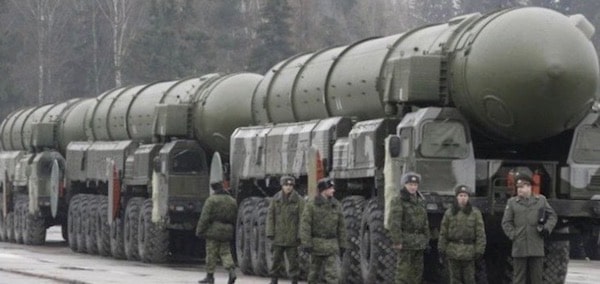The new Cold War is escalating, fueled by Washington’s bid to isolate or strangle Russia.
On November 10, a 5,290-ton Norwegian warship sank into one of the country’s inner fiords after colliding with a 62,557-ton tanker carrying almost 100 million liters of oil. CNN reported, “Now all that remains above the waterline is the frigate’s top, antennas and radar, leading local media to speculate how a ship designed for war failed to avoid a slow-moving, 62,557-ton tanker.”
Good question, and it will cost Norwegians an estimated $100 million to recover and repair its warship, but that’s minor compared to the damage that could be done by more military mistakes within its borders. In 1949, Norway joined NATO, and NATO nations have since enjoyed its “nuclear sharing ” largesse, by which member nations without nuclear weapons of their own participate in nuclear force planning, train their armed forces to use nuclear weapons, and store nuclear weapons in their territories. United States Air Force (USAF) personnel guard the nuclear weapons “shared” with NATO nations. The codes for deploying and firing them also remain under U.S. control.
In October 2016, Norway voted against a UN nuclear disarmament resolution, saying that it “will not support proposals that would weaken NATO’s role as a defense alliance.” A month later, a Russian official warned that Norway, which shares a border with Russia, had become a nuclear target due to the deployment of 330 U.S. Marines in its territory.
Norway’s ill-fated frigate sank at the end of the war-games phase of Trident Juncture, NATO’s massive military exercise on Russia’s Scandinavian and Arctic borders. The first phase of Trident Juncture was deployment, from August to October. The second phase, war games, lasted from October 25 to November 7, and was based on the premise that Russia had invaded Scandinavia by ground, by air, and by sea. The third phase was a command post exercise to rehearse control of a real military operation from within Norway and Italy. The exercise included 50,000 participants from 31 NATO and partner countries, 250 aircraft, 65 naval vessels, and up to 10,000 tanks and other ground vehicles. Its “modular combined petroleum unit” provided 25,000 gallons of jet fuel and 5,000 gallons of diesel fuel.
In his most recent podcast with Russian History professor Stephen F. Cohen, New York City radio host John Batchelor said, “Five or six years ago, this would have been science fiction. Nobody would have accepted this was possible, but it is entirely logical. This is the escalatory cycle of Cold War thinking. We are in the New Cold War, and each time these exercises will grow larger. The thinking in the original Cold War was that the scale of the exercise was a way of intimidating and in some fashion backing off the enemy. So the Russians conducted most recently a Vostok exercise in easternmost Siberia with the scenario of an invasion of Korea by an unnamed foe, meaning the United States. Now that was an exercise combining Chinese troops and Russian troops to fight this unnamed foe. Now the American troops and 30 other countries conduct an exercise to fend off an unnamed foe named Russia. These are very serious people. These exercises are not minor. The planning that goes into this and the money that’s spent means that both sides are preparing for conflict, or as Steve says, war with Russia. One more detail: within these last days, the Commission on National Defense Strategy organized by Congress, choosing senior officers retired from all militaries, Republican and Democrat, came together to issue a report to the Pentagon to say that, as of right now, the U.S. military is not prepared to fight straight up with Russia.”
Curious report, given that the Stockholm International Peace Research Institute ranks Russia’s military budget as the fourth greatest in the world, after those of the U.S., China, and Saudi Arabia, and one-tenth the size of the U.S. military budget. Are we being conned by the Pentagon and the military industrial complex? Hell yes, and that’s among the greatest understatements of the 20th and 21st centuries. Weapons manufacturers who profited from Trident Juncture and all the rest of the U.S.-financed NATO operations are no doubt laughing all the way to the bank, while Russia remains determined not to bankrupt its people in an arms race with the U.S., as the Soviet Union did.
Stephen F. Cohen, author of the new book “War with Russia,” said that Russia is the most resource-rich nation on earth, and that the attempt to isolate it with sanctions and vilification has failed. Instead, Russia’s global diplomatic status has increased, and it has become more economically self-sufficient because it was compelled to develop agricultural and industrial import substitutions in response to sanctions. As George Szamuely, Senior Research Fellow at the Global Policy Institute, says, “It’s ridiculous for the U.S. to imagine that it could isolate Russia. It’s not Iraq.” Indeed. It’s a major world power, a nuclear power, and a permanent member of the UN Security Council with veto power. And it continues to build alliances with other powerful nations, most importantly China and Iran.
The U.S. is by contrast an empire declining beneath the weight of its grotesque military budgets and wars, even if it’s not sinking as fast as Norway’s frigate in NATO’s latest war games. Question is, will its handlers take the rest of the world down with it, either by accident or on purpose?

